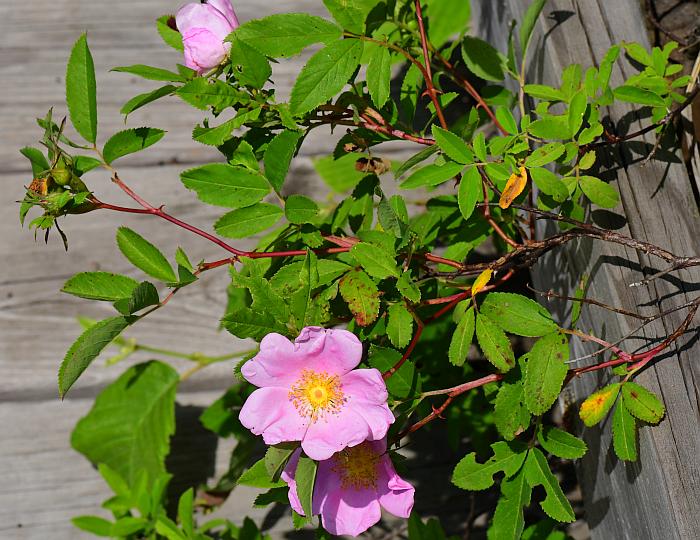Rosa palustris Marshall
Swamp Rose

Native
CC = 7
CW = -5
MOC = 15
© SRTurner
Rosa palustris MarshallSwamp Rose | |
 |
Native CC = 7 CW = -5 MOC = 15 |
© SRTurner |
|
Family - Rosaceae Habit - Shrub. Stems - Ascending to erect, to 2.5 m, sometimes forming colonies or thickets, relatively slender, reddish brown, the branches spreading to arched, with mostly paired prickles usually confined to the nodes, these 3.5-8.0 mm long, 2-5 mm wide, stout, mostly broadened at the base, curved or occasionally straight, flattened, the uppermost branches or rapidly elongating shoots sometimes with prickles and/or bristles between the nodes, lacking glands. Leaves - Alternate, pinnately compound, stipulate. Leaves 8-11 cm long; the petiole and rachis glabrous or sparsely pubescent with short or longer and somewhat woolly hairs, lacking glands or with few stalked glands, sometimes with short, straight or curved prickles. Stipules 10-22 mm long, 2.5-4.0 mm wide, the margins entire (but sometimes with glandular hairs) and usually somewhat curled under, the auricle straight or occasionally flared, 2.5-4.5 mm long. Leaflets 5 or 7, 20-45 mm long 10-18 mm wide, the terminal leaflet with a stalk 5-10 mm long, the blades narrowly ovate to elliptic or elliptic-oblanceolate, angled to more or less rounded at the base, angled at the sharply or bluntly pointed tip, the margins finely simply or occasionally doubly toothed with mostly 20-30 teeth per side, these sometimes gland-tipped, the upper surface dull or somewhat shiny, green to dark green, the undersurface pale green, glabrous or finely hairy along the main veins.
Inflorescence - Solitary flowers or more commonly clusters of 2-10 flowers on lateral branches from second year's stems and/or terminal on current year's growth, the flower stalks 6-15 mm long, with many stalked glands, with 2 bracts.
Flowers - Flowers not doubled, the hypanthium 2-4 mm long, with sparse to dense stalked glands, the mouth 1.0-1.5 mm in diameter. Sepals 15-30 mm long, 2.0-3.5 mm wide, usually slightly unequal, tapered to sharply pointed tips, the margins entire or with a few slender toothlike lobes, the undersurface with sparse to more commonly dense stalked glands, spreading to reflexed or erect and somewhat incurved after flowering, shed by fruit maturity or occasionally some of them persistent but withered. Petals 14-28 mm long, light pink to deep pink, frequently shriveling to form a small cap on the hip at fruiting. Pistils 24-50, the styles free, hairy, extending 0.5-1.0 mm beyond the mouth of the hypanthium, the mass of stigmas thus at most slightly elevated, more or less closing the hypanthium mouth.
Fruits - Hips 7-11 mm long, 7-11 mm wide, globose to subglobose or rarely slightly pear-shaped, fleshy, the surface deep red, with sparse to more commonly dense stalked glands. Achenes 12-28, 2.5-3.5 mm long. Flowering - May - July. Habitat - Bottomland forests, swamps, fens, marshes, seeps, pond margins, ditches, canals; often in shallow water. Also cultivated. Origin - Native to the U.S. Lookalikes - Many other species of Rosa. Other info. - Wild occurrences of this species are restricted to a cluster within the southeastern corner of the state, where swamps and lowlands prevail. Its broader range includes most of the eastern third of the continental U.S., particularly in the northern regions, and continues into Canada. Among other things, the plant is characterized by a growth habit which is usually densely shrubby. The stipules are long and narrow, the leaves finely toothed, and the hypanthia usually densely glandular. The plant does well in gardens with moist, acidic soils and can be trimmed into a hedge. Photographs taken near Loda Lake, Newaygo County, MI, 7-5-2023 (SRTurner). |